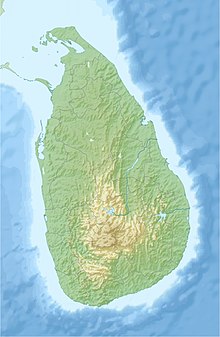Kanneliya-Dediyagala-Nakiyadeniya
| Kanneliya-Dediyagala-Nakiyadeniya | |
|---|---|
| Kanneliya-Dediyagala-Nakiyadeniya | |
| Location | Southern Province, Sri Lanka |
| Nearest city | Galle |
| Coordinates | 6°11′N 80°25′E / 6.183°N 80.417°ECoordinates: 6°11′N 80°25′E / 6.183°N 80.417°E |
| Area | 10,139 ha |
| Established | 2004 |
| Governing body | Department of Forest Conservation |
Kanneliya-Dediyagala-Nakiyadeniya or KDN is a forest complex in southern Sri Lanka. The forest complex designated as a biosphere reserve in 2004 by UNESCO. The KDN complex is the last large remaining rainforest in Sri Lanka other than Sinharaja. This forest area has been identified as one of the floristically richest areas in South Asia. The forest complex is situated 35 km northwest of city of Galle. The rain forest is a major catchment area for two of the most important rivers in southern Sri Lanka, the Gin and Nilwala Rivers. This biosphere reserve harbors many plants and animal species endemic to Sri Lanka.
The biosphere consists series of parallel mountain ranges and valleys. The elevation ranges from 60 m to 425 m above sea level. Mean annual temperature is 27.0 °C while annual temperature variation is 4 °C-5 °C. The forest receives a substantial rainfall of 3,750 mm. Many ancient taxonimic groups of Gondwana are present in these rain forests. They also relates to Indomalayan plants and animals.
The forest complex act as an important catchment area for many rivers and streams flow through the area. The forest is the source for Gin River, which flows west to the forest and for Nilwala river which flows east to the forest. Kanneli, Nanikiththa and Udugama are the smaller streams of Kanneliya while Homa dola and Gal bandi dola are sourced by Nakiyadeniya and Deiyagala.
The KDN forest complex shows a degree of floral endemicity, as 17 percent of lowland endemic floral species are confined to this forest area. Of 319 woody plants recorded in the area, about 52 per cent is endemic. The vegetation of KDN complex represents Sri Lanka lowland rain forests. The floral communities dominated by Shorea-Dipterocarpus-Mesua (Sinhalese "Doona-Hora-Na") are common in emergent layer of the forest.
...
Wikipedia

